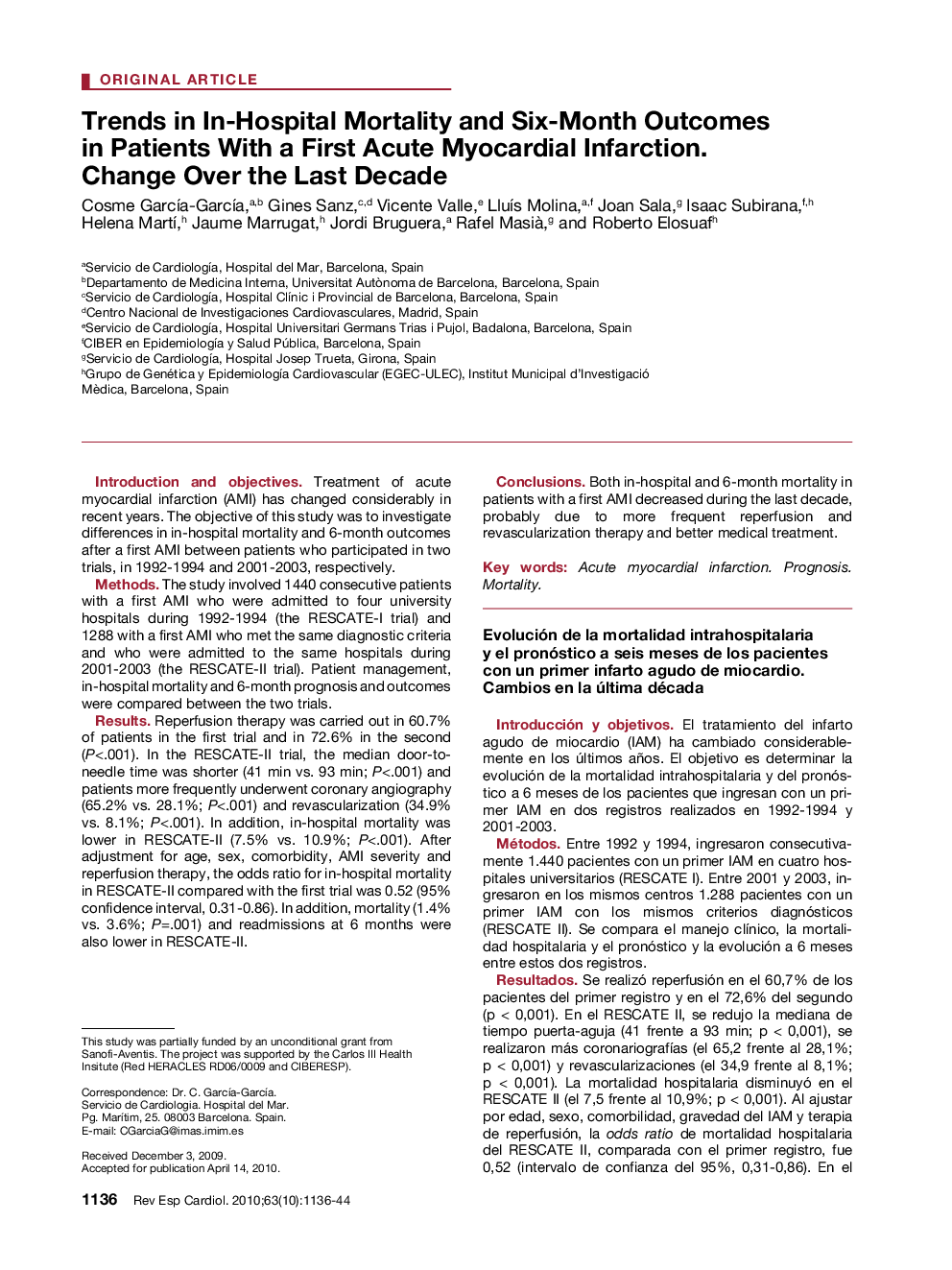| کد مقاله | کد نشریه | سال انتشار | مقاله انگلیسی | نسخه تمام متن |
|---|---|---|---|---|
| 3017081 | 1182106 | 2010 | 9 صفحه PDF | دانلود رایگان |

Introduction and objectivesTreatment of acute myocardial infarction (AMI) has changed considerably in recent years. The objective of this study was to investigate differences in in-hospital mortality and 6-month outcomes after a first AMI between patients who participated in two trials, in 1992–1994 and 2001–2003, respectively.MethodsThe study involved 1440 consecutive patients with a first AMI who were admitted to four university hospitals during 1992–1994 (the RESCATE-I trial) and 1288 with a first AMI who met the same diagnostic criteria and who were admitted to the same hospitals during 2001–2003 (the RESCATE-II trial). Patient management, in-hospital mortality and 6-month prognosis and outcomes were compared between the two trials.ResultsReperfusion therapy was carried out in 60.7% of patients in the first trial and in 72.6% in the second (P<.001). In the RESCATE-II trial, the median door-to-needle time was shorter (41 min vs. 93 min; P<.001) and patients more frequently underwent coronary angiography (65.2% vs. 28.1%; P<.001) and revascularization (34.9% vs. 8.1%; P<.001). In addition, in-hospital mortality was lower in RESCATE-II (7.5% vs. 10.9%; P<.001). After adjustment for age, sex, comorbidity, AMI severity and reperfusion therapy, the odds ratio for in-hospital mortality in RESCATE-II compared with the first trial was 0.52 (95% confidence interval, 0.31–0.86). In addition, mortality (1.4% vs. 3.6%; P=.001) and readmissions at 6 months were also lower in RESCATE-II.ConclusionsBoth in-hospital and 6-month mortality in patients with a first AMI decreased during the last decade, probably due to more frequent reperfusion and revascularization therapy and better medical treatment.
Introducción y objetivosEl tratamiento del infarto agudo de miocardio (IAM) ha cambiado considerablemente en los últimos años. El objetivo es determinar la evolución de la mortalidad intrahospitalaria y del pronóstico a 6 meses de los pacientes que ingresan con un primer IAM en dos registros realizados en 1992–1994 y 2001–2003.MétodosEntre 1992 y 1994, ingresaron consecutivamente 1.440 pacientes con un primer IAM en cuatro hospitales universitarios (RESCATE I). Entre 2001 y 2003, ingresaron en los mismos centros 1.288 pacientes con un primer IAM con los mismos criterios diagnósticos (RESCATE II). Se compara el manejo clínico, la mortalidad hospitalaria y el pronóstico y la evolución a 6 meses entre estos dos registros.ResultadosSe realizó reperfusión en el 60,7% de los pacientes del primer registro y en el 72,6% del segundo (p < 0,001). En el RESCATE II, se redujo la mediana de tiempo puerta-aguja (41 frente a 93 min; p < 0,001), se realizaron más coronariografías (el 65,2 frente al 28,1%; p < 0,001) y revascularizaciones (el 34,9 frente al 8,1%; p < 0,001). La mortalidad hospitalaria disminuyó en el RESCATE II (el 7,5 frente al 10,9%; p < 0,001). Al ajustar por edad, sexo, comorbilidad, gravedad del IAM y terapia de reperfusión, la odds ratio de mortalidad hospitalaria del RESCATE II, comparada con el primer registro, fue 0,52 (intervalo de confianza del 95%, 0,31–0,86). En el RESCATE II también disminuyó la mortalidad (el 1,4 frente al 3,6%; p = 0,001) y el reingreso a 6 meses.ConclusionesLa mortalidad intrahospitalaria y a 6 meses de los pacientes con un primer IAM ha disminuido en la última década, probablemente debido a que se reperfunde y se revasculariza más y al mejor tratamiento médico.
Journal: Revista Española de Cardiología (English Edition) - Volume 63, Issue 10, 2010, Pages 1136-1144